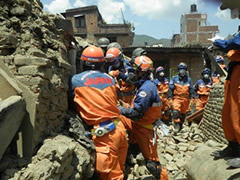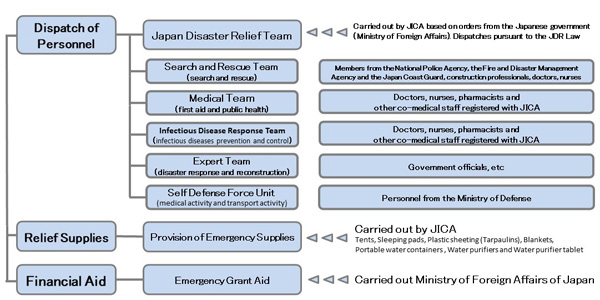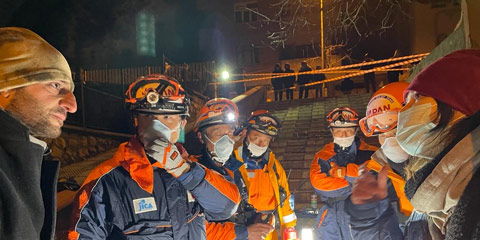
JDR team members work on site following the 2015 earthquake in Nepal.
JICA dispatches Japan Disaster Relief (JDR) teams based on orders from the Minister for Foreign Affairs and provides emergency relief supplies, when major disasters occur, mainly in but not limited to developing areas, in response to requests received from the governments of affected countries or international agencies.
Japan's disaster relief activities date back to the late 1970s, when medical teams were dispatched to assist Cambodian refugees. In September 1987, the Japan Disaster Relief Team Law (the JDR Law) was enacted to enhance dispatch systems for rescue and expert teams. A partial revision of the Japan International Cooperation Agency Law, which involves the addition of emergency relief supplies to its scope of operation, led to the establishment of Japan' s comprehensive emergency disaster relief system.
The JDR Law was partially amended in June 1992, making it possible for the Minister for Foreign Affairs, after consultations with the Minister of Defense, to send teams from the Japanese Self-Defense Force units (SDF) when large-scale aid is required following a large-scale disaster and self-sufficient activities are required in the disaster area.
Based on the response to the spread of Ebola in West Africa, in October 2015 the Japan Disaster Relief Infectious Disease Response Team has been established to carry out more effective assistance when global outbreaks of infectious diseases occur. In July 2016 infectious disease response team was dispatched for the yellow fever outbreak in Democratic Republic of the Congo as the first deployment.
JDR Activities
As personnel assistance, JICA's Disaster Relief Program dispatches rescue team, medical team, expert team, SDF and infectious diseases response team..
- The Rescue Team searches for missing people, rescues victims, provides first aid, and moves victim safely. The team is classified by the International Search and Rescue Advisory Group (INSARAG) as "heavy" (the highest rank).
- The Medical Team provides clinical care to victims. The team is classified by WHO as EMT Type 1 and Type 2 capable of providing an emergency field hospital for disaster response and to provide specialist cells for haemodialysis and surgery.
- The Expert Team provides guidance and advice on how best to manage disasters and achieve recovery.
- The SDF carries out emergency relief activities (epidemic prevention, medical activity and transport activity) when deemed necessary.
- The Infectious Disease Response Team does infectious diseases prevention and control in the fields of Epidemiology, Laboratory examination, Clinical treatment and Infection control, Public health response and Logistics.
As material assistance JICA provides emergency supplies, such as blankets and tents to assist in the recovery process.
Enhanced Alliance
Usually, major countries' aid agencies and international organizations provide relief support at the site of a large-scale disaster. The United Nations Office for the Coordination of Humanitarian Affairs (UNOCHA) takes the initiative to build systems for coordinating these disaster relief activities. JICA actively develops alliances with related organizations in order to contribute to the swift implementation of relief services at the disaster site.
JICA also cooperates with Japanese NGOs operating in affected areas in order to implement more effective operations.
Stockpiling Supplied at Bases around the World for Rapid Responses
To facilitate the rapid and reliable supply of the large-volume of relief items, reserve supplies must be procured and appropriately stockpiled in advance at locations as close as possible to disaster areas. Accordingly, JICA has warehouses worldwide, in Singapore, the Miami (United States), Dubai (UAE), Majuro (Marshalls) [1] and Koror (Palau) [1] . Six priority goods are stockpiled at these four locations-tents, sleeping pads, plastic sheeting (tarpaulins), blankets, portable water containers (plastic jerry cans) and water purifiers.
Note
- [1] A local warehouse set up for domestic use only. It is not expected that stockpiled relief items will be transported from the local warehouse to other countries.
Japan's International Disaster Relief

Dispatching of Japan Disaster Relief Team
As of December 2025
| FY | Rescue Team | Medical Team | Infectious Diseases Response Team |
Expert Team | Self Difense Force Unit |
Total |
|---|---|---|---|---|---|---|
| 1987 | 0 | 0 | - | 2 | 0 | 2 |
| 1988 | 0 | 4 | - | 2 | 0 | 6 |
| 1989 | 0 | 2 | - | 0 | 0 | 2 |
| 1990 | 2 | 2 | - | 2 | 0 | 6 |
| 1991 | 1 | 7 | - | 1 | 0 | 9 |
| 1992 | 0 | 1 | - | 2 | 0 | 3 |
| 1993 | 1 | 1 | - | 1 | 0 | 3 |
| 1994 | 0 | 0 | - | 1 | 0 | 1 |
| 1995 | 0 | 0 | - | 1 | 0 | 1 |
| 1996 | 1 | 1 | - | 0 | 0 | 2 |
| 1997 | 0 | 0 | - | 4 | 0 | 4 |
| 1998 | 1 | 4 | - | 1 | 1 | 7 |
| 1999 | 2 | 5 | - | 3 | 1 | 11 |
| 2000 | 0 | 3 | - | 0 | 1 | 4 |
| 2001 | 0 | 0 | - | 0 | 0 | 0 |
| 2002 | 0 | 0 | - | 2 | 0 | 2 |
| 2003 | 2 | 2 | - | 2 | 1 | 7 |
| 2004 | 1 | 8 | - | 4 | 2 | 15 |
| 2005 | 1 | 3 | - | 0 | 2 | 6 |
| 2006 | 0 | 1 | - | 1 | 1 | 3 |
| 2007 | 0 | 0 | - | 1 | 0 | 1 |
| 2008 | 1 | 2 | - | 0 | 0 | 3 |
| 2009 | 1 | 3 | - | 1 | 2 | 7 |
| 2010 | 3 | 2 | - | 4 | 2 | 11 |
| 2011 | 0 | 0 | - | 5 | 0 | 5 |
| 2012 | 0 | 0 | - | 0 | 0 | 0 |
| 2013 | 1 | 3 | - | 2 | 2 | 8 |
| 2014 | 0 | 1 | - | 3 | 2 | 6 |
| 2015 | 1 | 2 | 0 | 1 | 1 | 5 |
| 2016 | 0 | 0 | 1 | 0 | 1 | 2 |
| 2017 | 1 | 0 | 0 | 3 | 0 | 4 |
| 2018 | 0 | 1 | 1 | 1 | 1 | 4 |
| 2019 | 0 | 1 | 4 | 0 | 2 | 7 |
| 2020 | 0 | 0 | 0 | 3 | 0 | 3 |
| 2021 | 0 | 0 | 0 | 0 | 1 | 1 |
| 2022 | 1 | 3 | 0 | 2 | 1 | 7 |
| 2023 | 0 | 0 | 0 | 0 | 0 | 0 |
| 2024 | 0 | 0 | 0 | 0 | 0 | 0 |
| 2025 | 0 | 3 | 0 | 0 | 1 | 3 |
| Total | 21 | 65 | 6 | 55 | 25 | 172 |
Provision of Emergency Relief Supplies
As of December 2025
| FY | Provision of Supplies |
|---|---|
| 1987 | 3 |
| 1988 | 12 |
| 1989 | 7 |
| 1990 | 14 |
| 1991 | 19 |
| 1992 | 19 |
| 1993 | 18 |
| 1994 | 14 |
| 1995 | 16 |
| 1996 | 24 |
| 1997 | 19 |
| 1998 | 30 |
| 1999 | 22 |
| 2000 | 12 |
| 2001 | 9 |
| 2002 | 22 |
| 2003 | 15 |
| 2004 | 29 |
| 2005 | 19 |
| 2006 | 15 |
| 2007 | 22 |
| 2008 | 23 |
| 2009 | 14 |
| 2010 | 15 |
| 2011 | 19 |
| 2012 | 17 |
| 2013 | 16 |
| 2014 | 23 |
| 2015 | 10 |
| 2016 | 14 |
| 2017 | 16 |
| 2018 | 11 |
| 2019 | 10 |
| 2020 | 10 |
| 2021 | 13 |
| 2022 | 19 |
| 2023 | 3 |
| 2024 | 14 |
| 2025 | 11 |
| Total | 618 |





scroll